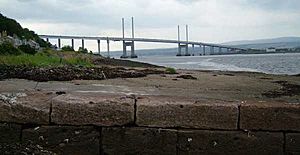Kessock Bridge facts for kids
Quick facts for kids Kessock Bridge |
|
|---|---|
 |
|
| Carries | A9 road |
| Crosses | Beauly Firth |
| Locale | Inverness, Scotland |
| Characteristics | |
| Design | Cable-stayed bridge |
| Total length | 1,056 metres (3,465 ft) |
| Longest span | 240 metres (787 ft) |
| History | |
| Opened | 1982 |
The Kessock Bridge (called Drochaid Cheasaig in Gaelic) is a very important bridge in Scotland. It carries the A9 main road over the Beauly Firth near Inverness. This bridge helps people travel easily between the north and south of Scotland.
Contents
What is the Kessock Bridge?
The Kessock Bridge is a special type of bridge called a cable-stayed bridge. It stretches across the Beauly Firth, which is an arm of the larger Moray Firth. The bridge connects the village of North Kessock with the city of Inverness in the Scottish Highlands.
How Big is the Kessock Bridge?
This impressive bridge is 1,056 metres (3,465 ft) long in total. Its main section, which is supported by cables, spans 240 metres (787 ft). A German engineer named Hellmut Homberg designed it. The Cleveland Bridge built it. The bridge looks similar to one found over the Rhine river in Düsseldorf, Germany.
Why is the Bridge so High?
The Beauly Firth is a waterway where boats can travel. Because of this, the Kessock Bridge had to be built high above the water. This allows ships to pass underneath safely. The four tall towers of the bridge stand out in the Inverness skyline. They look especially cool at night when they are lit up!
Kessock Bridge and Travel
The Kessock Bridge is a key part of the A9 main road. It helps traffic move north from Inverness towards the Black Isle. It is the first of three major bridge crossings in the Highlands. These bridges have made road travel much faster and easier in the area. The Kessock Bridge has also helped the city of Inverness grow a lot.
How the Bridge Stays Safe
The bridge is built to be very strong. It even has special parts called seismic buffers. These buffers help protect the bridge from any shaking if there's an earthquake. This area is near the Great Glen Fault, which is a natural crack in the Earth's crust. Each buffer is over 3 metres (9.84 ft) long and weighs about 2.5 tonnes (2.46 long tons; 2.76 short tons).
On the south side of the bridge, you can find the Caledonian Stadium. This is the home stadium for the Inverness Caledonian Thistle football team.
History of the Kessock Bridge
Before 1982, people traveling north from Inverness had to take a ferry across the Firth. Or they had to drive a much longer way around through Beauly. The Kessock Bridge made travel much quicker and simpler.
Building the Bridge
The company Cleveland Bridge won the contract to build the bridge in 1975. The cost was about £17.5 million. Construction started in 1976 and the bridge was finished and opened in 1982. It even won an award for its design and construction called the Saltire Award.
How Many People Use It?
In 2012, Transport Scotland estimated that about 30,000 vehicles used the bridge every single day! That's a lot of cars and trucks.
Bridge on Money
Since 2007, the Kessock Bridge has been featured on the £100 note issued by the Bank of Scotland. This series of banknotes celebrates amazing Scottish engineering achievements. Other bridges like the Glenfinnan Viaduct and the Forth Bridge are also shown on these notes.
Bridge Upgrades
From February to June 2013, the bridge underwent important repairs. The southbound side of the bridge had its surface replaced. This big project was managed by Transport Scotland. The new surface is expected to last for over 30 years, keeping the bridge safe and smooth for drivers.
In 2019, the Kessock Bridge was given a special "Category B listed status" by Historic Environment Scotland. This means it's recognized as an important historical building that should be protected.


